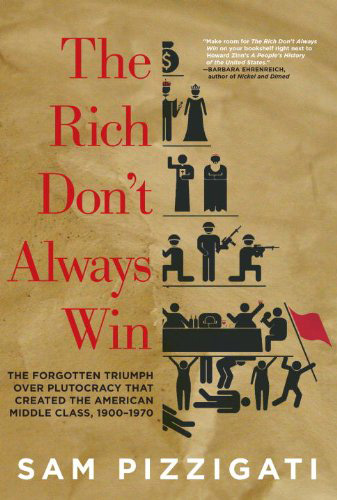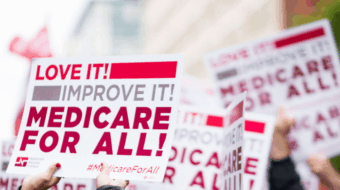
WASHINGTON – Unionists and other activists “must not be afraid to be bold” to attack U.S. income inequity and “the plutocracy” that once again imposes its will on the country, a noted analyst of income inequity says.
Author Sam Pizzigati, a retired communications specialist for unions, and editor of Too Much, an online newsletter about inequity, added that the inequity and plutocracy are so bad that they make the U.S. now look historically like a combination of 1929 – before the Great Depression – and the Gilded Age, before the Progressive Era.
Pizzigati’s critique was part of his discussion of economic history, positive and negative, outlined in his new book, at a June 3 talk at the AFL-CIO. The Rich Don’t Always Win: The Forgotten Triumph Over Plutocracy That Created The American Middle Class, 1900-1970 shows how, especially in the 1930s and 1950s, inequality lessened, thanks to the New Deal and the strength of the labor movement.
It also details how those victories were won, plus the roles of the nation’s leading corporate tax attorney – who openly advocated for high income tax rates on the top dollars the rich earned – and other corporate titans, who put the country’s interests first.
In World War II, Pizzigati noted, that tax attorney, Randolph Paul, who is no relation to the present Republican Kentucky senator, helped FDR author tax legislation that would have taxed every penny (100 percent) of all income above $25,000, equal to $350,000 in today’s dollars. FDR didn’t get that, but he got a top tax rate above 90 percent.
In the 1950s, unions ensured prosperity through their bargaining strength, and income inequality lessened, Pizzigati said. “In 1950, Charlie Wilson, the president of General Motors, earned $586,000, the equivalent of $5 million today. He paid $428,000, or 73 percent in taxes.
“In the first half of the 20th century, unions were significantly raising incomes of those at the bottom and helping to enact progressive taxes, which lowered incomes of those at the top,” like Wilson, he added.
That high rate didn’t start to fall until two Democratic presidents, John F. Kennedy and Lyndon Johnson, proposed tax cuts in 1963-64, which the Democratic-run Congress enacted. Kennedy proposed a much lower rate for capital gains, while Johnson cut the top income tax rate from 91 percent to 65 percent. It skidded further under presidents of both parties, Pizzigati said. The top rate is now 39.6 percent.
“With a 91 percent rate, we didn’t have high executive pay and high tax avoidance,” Pizzigati added.
What the proponents of low taxes on the rich deliberately ignore, Pizzigati said, is that 1930s union organizing and 1950s union density built the broad U.S. middle class – and the broad prosperity most people enjoyed until the early 1970s.
And the wealthy elite agreed to the high taxes because they remembered what happened when taxes were slashed in the 1920s and plutocracy triumphed then, followed by the Great Depression, he said.
Randolph Paul and the corporate executives whom he advised “saw that intense concentration of wealth ushered in the Great Depression and the Great Depression ushered in World War II. They felt we couldn’t risk more political instability like that, and that income inequality would make that inevitable.”
But since the 1970s, the ruling elite has successfully campaigned to restore the income gulf between themselves and the rest of us, and has created a “plutocracy” that gets what it wants politically and virtually runs the country, Pizzigati added.
So activists must be bold in attacking that plutocracy and income inequality, Pizzigati declared. Some of ideas they could advocate include:
- “Leveraging the power of the public purse” to level incomes. “Activists in the United Kingdom are doing that. Governments here spend billions on contracts, with few strings attached except for bans on discrimination by race and gender. Why should we subsidize corporations with great pay inequity? There should be no funds going to those where the CEO makes more than 25 times the average worker.” The average U.S. top corporate CEO last year made 354 times the average worker, data show.
- Fight back against right wing ideology that says “taxes can never work.” Pizzigati noted that when marginal tax rates were at their height against the rich, the U.S. used the funds to build its infrastructure and lift up the poor into the middle class.
- Campaign not only for higher income tax rates on the rich, but higher tax rates – and higher collections – from corporations. In the early 1950s, corporations paid a much larger percentage share of the costs of running government. Now they pay 10 percent or less.
“Progressives can’t be afraid to be bold,” Pizzigati said. “The United Auto Workers and the CIO pushed FDR to put that 100% tax rate idea on the table. But now the tax burden in the U.S., including all taxes, has turned the idea of progressive taxation on its head.”
Pitzzigati’s book, published by Seven Stories Press, is available in paperback and a Kindle edition.










